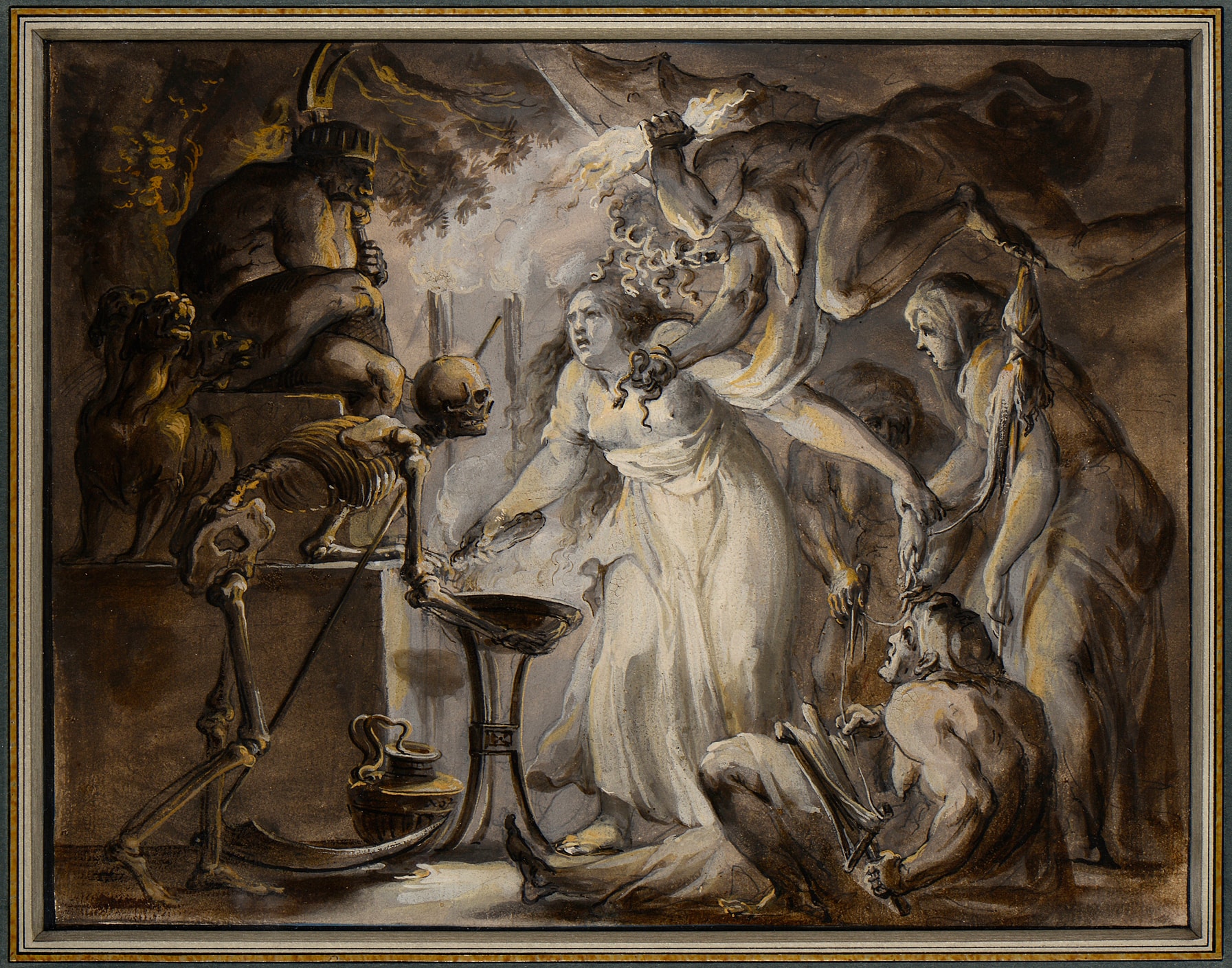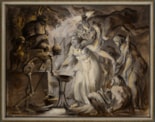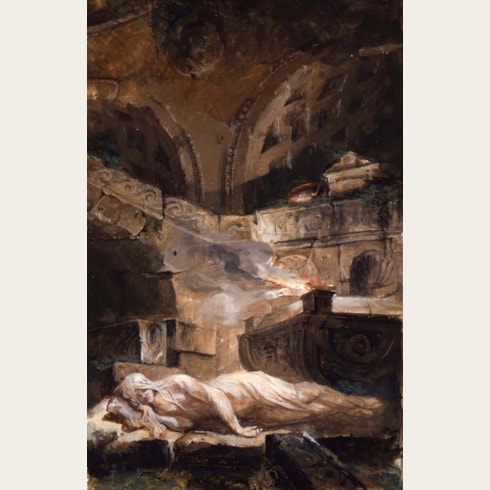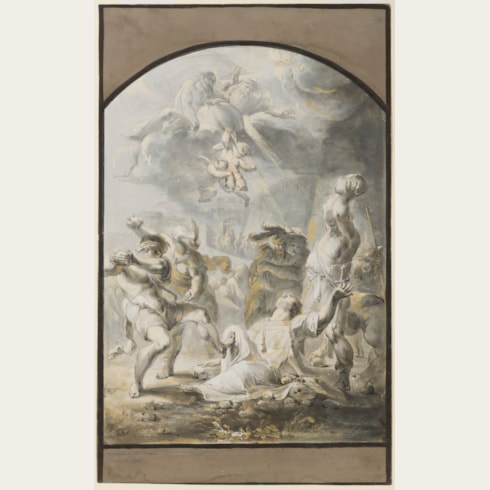Giovanni DAVID
(Cabella Ligure 1743 - Genoa 1790)
A Nightmare
Sold
Pen and grey ink, with grey and brown wash, heightened with white and yellow, over an underdrawing in black chalk.
The composition set within a fictive mount, drawn with a blue wash border and black framing lines.
237 x 306 mm. (9 3/8 x 12 in.)
The composition set within a fictive mount, drawn with a blue wash border and black framing lines.
237 x 306 mm. (9 3/8 x 12 in.)
Although the present sheet cannot be related to any known painting or print by Giovanni David, as Mary Newcome has noted, ‘the drawing is nevertheless characteristic of the technical skill and the powers of imagination of the artist, who was capable of creating visions rich in colourful characters as well as detailed still lifes.’ Here, the scene depicted is the entrance to Hades, the underworld. A bare-breasted woman lights a torch from a brazier held by Death, accompanied by his scythe, while above her hovers a winged demon holding thunderbolts and snakes in his hands. At the upper left sits King Minos, judge of the dead, attended by the three-headed dog Cerberus. At the right are the three Fates. Standing at the right is Clotho, the youngest of the Fates, who holds the staff with the thread of human life that she has spun, while her sister Lachesis reclines on the ground holding the thread of life, which is being cut with shears by Atropos, the eldest Fate.
In mood and macabre subject, this drawing may be likened to a highly finished drawing by David - an allegorical representation of the imagined death of the artist himself during the plague in Venice in 1780 - in the Philadelphia Museum of Art. The Philadelphia drawing also includes a similar skeletal figure of Death, as well as the three Fates. Among other stylistically similar drawings is An Allegory of the Wool Guild, with Minerva and the Fates and the Durazzo Coat of Arms of c.1777, in a New York private collection, in which the Three Fates are also prominently depicted.
Highy finished drawings such as this are a testament to the creative powers of Giovanni David; an artist who, as has been aptly noted, ‘succeeded in formulating some of the most complex, imaginative scenes to be found in Genoese art in the late eighteenth century.’
In mood and macabre subject, this drawing may be likened to a highly finished drawing by David - an allegorical representation of the imagined death of the artist himself during the plague in Venice in 1780 - in the Philadelphia Museum of Art. The Philadelphia drawing also includes a similar skeletal figure of Death, as well as the three Fates. Among other stylistically similar drawings is An Allegory of the Wool Guild, with Minerva and the Fates and the Durazzo Coat of Arms of c.1777, in a New York private collection, in which the Three Fates are also prominently depicted.
Highy finished drawings such as this are a testament to the creative powers of Giovanni David; an artist who, as has been aptly noted, ‘succeeded in formulating some of the most complex, imaginative scenes to be found in Genoese art in the late eighteenth century.’
Only a handful of paintings, frescoes and drawings survive from the brief career of Giovanni David, a Genoese artist succinctly described by his biographer Federico Alizeri as ‘with few known works, a bizarre style, and an obscure, almost mysterious life’. David studied with Domenico Corvi in Rome in the early 1770s, assisting him in such works as the fresco decoration of the Palazzo Borghese, and winning a first prize at the Accademia di San Luca in 1775. He spent some time in Naples and in Venice before returning to Genoa at the end of the 1770s. There he entered the service of the Genoese count Giacomo Durazzo, who had earlier sponsored David’s artistic training and who was to be his protector and chief patron throughout his career. Indeed, David was the artist-in-residence for the Durazzo family for much of his life. He executed a number of paintings for Genoese churches, including Santa Maria in Carmine, the convent of Santa Maria in Rifugio and Santa Maria delle Vigne, although little remains of one of his last major projects, the decoration of the Genoese church of Sant’Agnese.
Although he worked mainly in Genoa, where he lived in the Palazzo Durazzo, David also spent some time in Venice between 1775 and 1776, when he produced a large number of prints of allegorical, literary and genre subjects, as well as reproductive etchings after the work of earlier artists, including Andrea Mantegna, Jacopo Bellini and Giulio Romano. Many of his prints seem to have been commissioned by Giacomo Durazzo, or were dedicated to him. It was during his brief stay in Venice that David worked as a scene painter at the theatre of La Fenice, probably also at the instigation of Durazzo. Back in Genoa, David received one of his most important secular public commissions, for two lunette paintings for the Sala del Maggior Consiglio of the Palazzo Ducale, completed in 1780. David is known to have travelled to France, the Low Countries and England between September 1785 and October 1786; a trip recorded in a pair of albums containing around 180 topographical drawings which were at one time in the collection of the 19th century Genoese sculptor Santo Varni and are today in the Royal Library at Windsor Castle. One of David’s final projects was the design of a catafalque in honour of Carlo III de’Bourbon, erected in the church of San Lorenzo in 1789, a year before the artist’s death at the relatively young age of forty-one.
Although he worked mainly in Genoa, where he lived in the Palazzo Durazzo, David also spent some time in Venice between 1775 and 1776, when he produced a large number of prints of allegorical, literary and genre subjects, as well as reproductive etchings after the work of earlier artists, including Andrea Mantegna, Jacopo Bellini and Giulio Romano. Many of his prints seem to have been commissioned by Giacomo Durazzo, or were dedicated to him. It was during his brief stay in Venice that David worked as a scene painter at the theatre of La Fenice, probably also at the instigation of Durazzo. Back in Genoa, David received one of his most important secular public commissions, for two lunette paintings for the Sala del Maggior Consiglio of the Palazzo Ducale, completed in 1780. David is known to have travelled to France, the Low Countries and England between September 1785 and October 1786; a trip recorded in a pair of albums containing around 180 topographical drawings which were at one time in the collection of the 19th century Genoese sculptor Santo Varni and are today in the Royal Library at Windsor Castle. One of David’s final projects was the design of a catafalque in honour of Carlo III de’Bourbon, erected in the church of San Lorenzo in 1789, a year before the artist’s death at the relatively young age of forty-one.
Provenance
Anonymous sale, Milan, Sotheby’s, 8 May 2001, lot 435
Jean-Luc Baroni Ltd., London, in 2002
Private collection.
Literature
Adriano Cera, ed., Disegni, acquarelli, tempere di artisti italiani dal 1770 ca. al 1830 ca., Bologna, 2002, Vol.I, unpaginated, David no.7; Mary Newcome Schleier and Giovanni Grasso, Giovanni David: Pittore e incisore della famiglia Durazzo, Turin, 2003, p.52, no.D20; Anne Lafont, ‘Genova alle origini del romanticismo francese: Girodet e Gros in Italia’, in Piero Boccardo, Clario Di Fabio and Philippe Sénéchal, ed., Genova e l’Europa: Opere, artisti, committenti, collezionisti, Cinisello Balsamo, 2003, p.251, fig.11.
Exhibition
New York and London, Jean-Luc Baroni Ltd., Master Drawings, 2002, no.27; Boston, Museum of Fine Arts, Splendor and Elegance: European Decorative Arts and Drawings from the Horace Wood Brock Collection, 2009, no.132.






